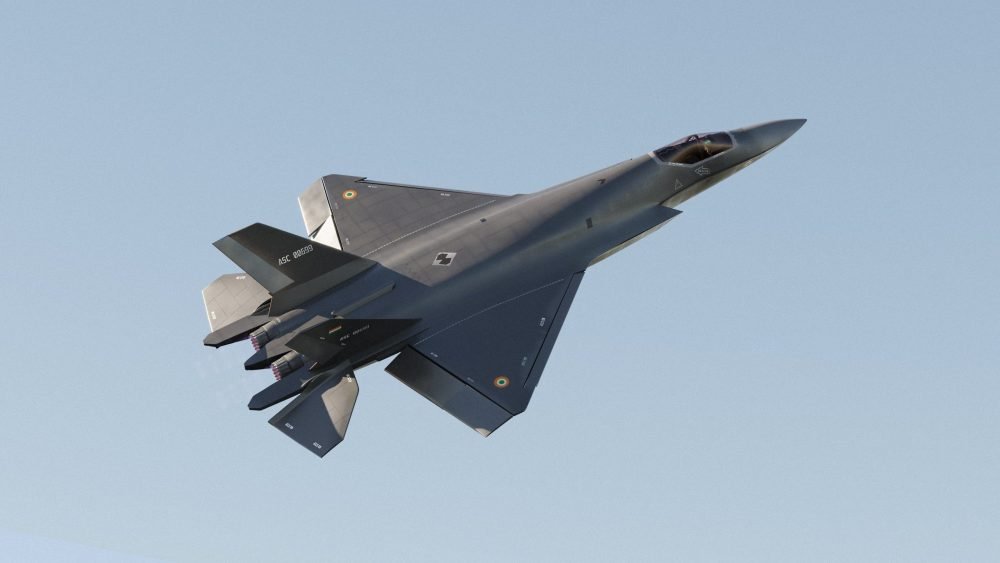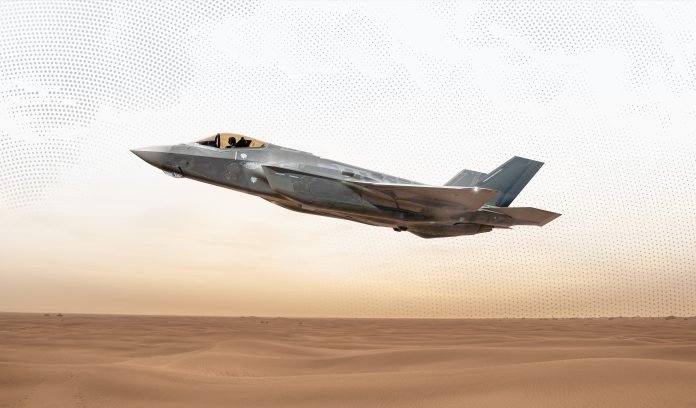Ever since Donald Trump dangled the prospect of two squadrons of F-35s for India, and especially after the stunning aerial ballet of the F-35 and Su-57 at Aero India this past February, the Indian aviation community has been abuzz with talk of a potential stealth fighter deal.
So, what path should India take? Let’s begin with the costs – a key factor for a developing country. Germany is spending a whopping $9 billion for thirty-five F-35s. The flyaway cost of the F-35 hovers around $110 million, meaning the price tag likely includes setup, support, spares and training for an eventual total of about $257 million per aircraft. But what if India diverted that colossal sum toward its Advanced Medium Combat Aircraft (AMCA)? That kind of investment could turbocharge the AMCA programme, potentially bringing it years ahead of schedule. It could also allow the project to be hived off from HAL to a private sector special-purpose company, possibly led by industry giants like Tata, Adani or Godrej, allowing India to take the reins of its cutting-edge aerospace future.
The AMCA is a single-seat, twin-engine, all-weather stealth marvel designed for multi-role combat. Like many HAL projects, the AMCA has faced delays, but that doesn’t mean it’s destined for failure. Look at the Tejas light combat aircraft – a project that, despite its early challenges, now serves as a reliable workhorse for the Indian Air Force. Under the leadership of the late Defence Minister Manohar Parrikar, HAL successfully delivered the Tejas. However, unless there’s a drastic timeline shift, an AMCA prototype may not take to the skies before 2030, and an operational squadron could be at least five more years down the road.
If the AMCA is too distant a dream, India could opt for a more immediate solution: acquiring a limited number, perhaps two squadrons, of F-35s or Su-57s to catapult the IAF into stealth warfare realms. The decision comes down to what the IAF values most – more stealth at the cost of manoeuvrability, or high manoeuvrability at the expense of stealth.
F-35 – Networked Beast
The F-35, the ultimate networked combat system of the United States, is a powerhouse when it comes to data-sharing in combat, stealth, supercruise, and long-range detection and elimination of targets via air-to-air missiles. But it is not a nimble dogfighter. Its stealth design limits its weapon capacity, with internal bays restricting the number of armaments it can carry. Externally mounted weapons would increase its radar cross-section and, in turn, compromise its stealth.
Both the F-35 and Su-57 are formidable options, but each has inherent limitations for India. The F-35’s dependence on US-controlled software updates, its potential for strategic vulnerabilities, and the unproven status of the Su-57 make these foreign jets less desirable for India in the long term
Speed-wise, the F-35 lags at a top speed of 1,200 mph, while the Su-57 soars ahead at 1,616 mph. Range? The Su-57 is an endurance champion, boasting a remarkable 3,107-mile combat radius compared to the F-35’s more modest 1,380 miles. The Su-57 also outdoes the F-35 in altitude, reaching a staggering 65,617 feet, well beyond the F-35’s 50,000-foot ceiling. Clearly, the Su-57 holds the advantage in these areas of combat.
But these factors don’t bother the US much. America’s military strategy hinges on swarming the enemy with overwhelming numbers, ensuring that enemy air defences are crushed, and frontline forces obliterated. With nearly 800 F-35s in service in the US military and an eventual fleet of over 2,000 planned, the F-35’s volume alone is a war-winning asset. Short of Russia – with its specialised stealth-detecting radars; swarms of formidable air-defence fighters; and powerful air defence systems like the S-400 – no air force can realistically survive an all-out F-35 assault. Just ask the Iraqi pilots who tried (and failed) to fend off thousand-bomber raids during Desert Storm.

Kill Switch
Contrary to speculation, both in mainstream and social media, the F-35 does not have a kill switch that can turn a stealth fighter into the world’s most expensive static display model. But here’s the problem – in the unlikely event that the US would want to ground an F-35 sold to another country, it has other ways to do so. Because the aircraft is designed as a completely software-driven weapons platform, the F-35 is effectively a giant kill switch. Simply cutting off software updates would start impacting the aircraft’s war-fighting capabilities. But still, the impact wouldn’t be immediate – that is, F-35s won’t suddenly start tumbling out of the sky.
The F-35 is essentially a flying networked combat system, dependent on software-driven upgrades for mission success. Without these updates, the F-35 can still take off and fly, but its ability to fight, adapt to new threats, and penetrate advanced defences will be severely compromised.
Secondly, let’s say you are an F-35 operator and you decide to override Lockheed and try to reboot your stealth fighter with the help of your own software engineers. Good luck with that. According to the 350th Spectrum Warfare Group’s F-35 Program Support Cell, international F-35 operators are not allowed to conduct independent test operations outside the continental United States. US government security rules and National Defense Policy require that only US citizens perform specific functions in order to protect critical US technology.
But what if you ignore US rules, hack the onboard system and fly the F-35 anyway? Well, minus the updates from Lockheed, the combat effectiveness of your stealth aircraft would progressively decline – just like your phone slows down and becomes vulnerable to viruses once Android, or Apple stops sending updates to that particular model.
The harsh reality of the fifth/future-generation fighters is that they will be highly software-dependent aircraft that will forever be connected to the manufacturer for the life of that system. In such a scenario, countries that are dependent on imports for their frontline air superiority fighters will have a window of vulnerability that can be exploited by the supplier country. How they navigate will depend on their ties with the US.
While the F-35 will be the primary air superiority fighter for several NATO countries, Japan, Israel and Australia, the risk of dependence on foreign software and hardware in a combat system as sophisticated as the F-35 is a genuine concern for countries like India that value sovereignty in defence matters.
The flyaway cost of the F-35 hovers around $110 million, meaning the price tag likely includes setup, support, spares and training for an eventual total of about $257 million per aircraft. The Su-57’s lower price tag – around $40 million or roughly the same as the indigenous Tejas – makes it an attractive option
Su-57 – Dogfight Duke
The Su-57, by contrast, embodies a Russian philosophy that prioritises super-manoeuvrability over stealth. While many jet fighters are designed for long-range kills, Russian doctrine acknowledges that aerial combat often ends in a knife fight. In these close-quarter engagements, manoeuvrability reigns supreme – a belief that resonates strongly with the IAF whose pilots are trained to excel in this very scenario. Plus, the Su-57’s lower price tag – around $40 million or roughly the same as the indigenous Tejas – makes it an attractive option.
Moreover, the Su-57 is the only fighter equipped with Directed Infrared Counter Measures, an innovative system that uses laser turrets to blind incoming IR missiles, preventing them from homing in on their target. This could be a game-changer in modern aerial warfare, as such systems have previously been reserved for transports and helicopters. For the Su-57 to carry this system shows Russia’s commitment to innovation in air combat.

That said, the Su-57 still faces significant hurdles. It lacks a true supercruise engine, though the forthcoming AL-51 engine could potentially remedy this shortcoming. Its most pressing issue, however, is its immaturity as a programme. With fewer than 30 units delivered and only 76 more on order, the Su-57 is still very much in the prototype stage. Also, there are rumours of Sukhoi working on the more advanced Su-75 stealth fighter. If true, will it remain committed to the Su-57?
By contrast, the F-35 has already racked up over 1,100 deliveries. In fact, Russia’s stealth programme has been playing catch-up for over two decades. As India considers the Su-57, it should weigh this reality – especially since the US has long been flying the highly classified F-22, a fighter that outclasses the Su-57 in many aspects, and has been in service since 2005.
India’s flirtation with the Su-57 dates back to 2010, when it inked a deal with Russia to co-develop the fighter. Both sides agreed to invest $6 billion each. However, the project quickly became mired in delays, lack of transparency and technology-sharing disputes. By 2018, the IAF had pulled out of the programme, citing concerns over cost, performance, and the Russians’ unwillingness to share critical technologies.
Which brings us to the AMCA
Rather than splurging billions on an unproven foreign fighter, India would be wiser to fast-track its indigenous AMCA programme. The AMCA – a fifth-generation tactical deep-strike fighter – has the potential to drastically enhance India’s strategic position, offering both technological sovereignty and the ability to address emerging threats with homegrown solutions.
India is already moving to accelerate the AMCA’s development. A top-level committee led by the Defence Secretary has been working hard to reduce development timelines and ramp up production efficiency. The programme’s urgency has been underscored by growing regional security concerns, including Pakistan’s interest in acquiring China’s J-31 stealth fighters and Beijing’s deployment of the Chengdu J-20 near India’s borders.
The AMCA, with its 25-ton design, promises to excel across a range of mission profiles: air superiority, strike and electronic warfare. Advanced avionics, including cutting-edge radar systems, sensors, and communication equipment, ensure superior situational awareness and combat effectiveness. With super cruise capability, it will also maximise fuel efficiency, boosting its range and endurance.
The true value of investing in the AMCA is the benefits it would bring to India’s defence industry. A successful stealth programme would boost national security and stimulate the domestic defence sector, creating jobs, attracting investment and bolstering India’s position as a global player in the arms market
However, the true value of investing in the AMCA is the benefits it will bring to India’s defence industry. A successful stealth programme would not only boost national security but also stimulate the domestic defence sector, creating jobs, attracting investment and bolstering India’s position as a global player in the arms market. With countries increasingly looking for advanced yet cost-effective fighter aircraft, the AMCA could become a key export product, positioning India as a serious player on the global aviation stage.
With key figures from the IAF, DRDO and ADA overseeing the project, the AMCA is on track for a first test flight by 2028. If India stays the course, it could leapfrog into the next generation of stealth fighters, solidifying its strategic position for years to come.
Conclusion
While the F-35 and Su-57 are both formidable options, they come with inherent limitations, especially for India. The F-35’s dependence on US-controlled software updates and the potential for strategic vulnerabilities, coupled with the unproven status of the Su-57, make these foreign fighters less desirable for India in the long term. The AMCA, by contrast, represents an opportunity for India to build a world-class fighter tailored to its specific needs, while securing technological sovereignty and strengthening its domestic defence industry. Therefore, India should prioritise the acceleration of the AMCA programme to ensure its future air superiority and strategic autonomy.
–The writer is a globally cited defence analyst based in New Zealand. The views expressed are of the writer and do not necessarily reflect the views of Raksha Anirveda






